
Do you want to learn how to dumpster dive and get free food, furniture, and other valuable items? Dumpster diving may seem unconventional, but it’s a sustainable way to reduce waste while saving money. In this guide, we’ll cover everything you need to know about how to dumpster dive safely and successfully.
By the end, you’ll understand the process, know what to look for, where to go, and have essential tips from experienced divers. So let’s dive in (no pun intended!) and discover the secrets to fruitful dumpster diving.
What is Dumpster Diving?
Dumpster diving, also known as bin diving or dumpstering, is the practice of rummaging through commercial and residential dumpsters or trash bins to find valuable or reusable items that have been discarded. People dumpster dive for various reasons, such as:
- Finding free food that’s still edible despite being thrown away
- Obtaining furniture, electronics, and other household goods in good condition
- Reducing waste and environmental impact by reusing items instead of sending them to landfills
- Making extra money by reselling valuable finds
Dumpster diving is popular among those on a budget, students, backpackers, environmentalists, and anyone seeking a sustainable lifestyle.
Is Dumpster Diving Legal?
The legality of dumpster diving varies by location, so it’s crucial to research your local laws and regulations before attempting it. In most places, dumpster diving itself is not considered illegal if the dumpster is located in a public area and doesn’t have any “No Trespassing” signs.
However, you could potentially face charges like trespassing or theft if you enter private property or rummage through dumpsters explicitly marked as off-limits. Always respect private property and exercise caution when dumpster diving.
How to Start Dumpster Diving (Process Overview)
Now that you understand what dumpster diving is and have considered the legal aspects, let’s go over the overall process for getting started:
Preparing for Your First Dive
- Research Local Laws and Regulations: As mentioned, make sure you understand the legalities surrounding dumpster diving in your area to avoid any issues.
- Scout Potential Locations: Look for neighborhoods or areas with restaurants, grocery stores, colleges, or apartment complexes, as these tend to be dumpster diving hotspots.
- Know What to Look For: Common finds include food (canned/packaged goods, produce), furniture, electronics, books, clothes, and more. Have a general idea of what you’re hoping to find.
- Mentally Prepare Yourself: Dumpster diving can be messy and unappealing to some. Overcome any reluctance by reminding yourself of the potential rewards and environmental benefits.
Gearing Up
To make your dumpster diving adventures more efficient and hygienic, you’ll need some essential gear:
- Durable Clothing: Wear old clothes, long pants, and closed-toe shoes to protect yourself from dirt and potential hazards.
- Gloves: Thick work gloves will keep your hands safe from sharp objects and contaminants.
- Bags or Containers: Bring sturdy bags or bins to store your finds.
- Flashlight or Headlamp: A reliable light source is crucial for seeing inside dumpsters, especially at night.
Other optional but useful items include a small stool or crate (to reach into dumpsters), hand sanitizer, multi-tool, and transportation (vehicle or bike for hauling larger finds).
Dumpster Diving 101
With the basics covered, let’s delve into the nitty-gritty of how to dumpster dive successfully.
Where to Look
While you can find treasures in all kinds of dumpsters, some locations are better than others:
Grocery Stores
One of the best places to dumpster dive for food is behind grocery stores. These establishments routinely discard perfectly edible (but past sell-by date) produce, baked goods, canned items, and more.
Colleges and Universities
When students move out of dorms or off-campus housing, they often discard furniture, appliances, electronics, and other household goods in great condition.
Residential Areas
Keep an eye out for dumpsters in upscale neighborhoods, especially during spring cleaning or when people are moving. You may find quality furniture, decor, and even antique items.
Other Potential Spots
Other dumpster diving hotspots include: restaurants (for surplus food), bookstores, office buildings, construction/renovation sites, and retail shops like electronics, clothing, or furniture stores.
Strategies and Safety
Best Times to Go
The optimal dumpster diving times are typically early morning (after businessesopen and toss night’s surplus) or late evening when everything is closed. Avoid peak hours when employees or customers may be present.
Solo vs. Group Dives
Going with a buddy can be safer and more efficient, as one person can keep watch while the other digs. However, solo diving allows you to be stealthier.
Entering Dumpsters
Use caution when entering a dumpster. Open lids carefully, watch for hazards like broken glass or needles, and never force open a locked dumpster.
Dealing with Confrontations
If caught dumpster diving, remain calm and respectful. Leave immediately if asked, as you could potentially face trespassing charges otherwise.
Finding the Jackpot
Once you’ve located some promising dumpsters, it’s time to dig for treasure! A few tips:
- Prioritize Sealed Foods: Look for undamaged, unexpired canned goods, packaged snacks, and other sealed food items first.
- Be Selective with Perishables: Unless you plan to consume found perishables immediately, avoid meat, dairy, unwrapped baked goods, etc.
- Inspect Before Taking: Quickly assess the condition of non-food items before adding them to your haul. Is that dresser easily repairable?
- Don’t Take More Than You Need: Only take what you can realistically use or redistribute to avoid creating more waste.
Processing Your Haul
So you’ve struck gold and loaded up on all kinds of dumpster treasures – now what? Proper cleaning and storage are crucial.
Cleaning and Storing Food
For any salvaged food:
- Perishables: Cook or consume same-day if meat, dairy, produce, etc. Discard if they’ve been sitting too long.
- Canned/Packaged Goods: Rinse off any grime or residue before storing as usual.
- Packaging Damage?: If packaging is compromised, inspect contents closely and discard if there are any signs of contamination.
Cleaning Non-Food Items
When it comes to non-food dumpster finds:
- Clothing and Linens: Run through a hot water sanitizing cycle in the washing machine.
- Furniture: Use wood cleaners, leather conditioners, or all-purpose cleansers to scrub down and disinfect.
- Electronics: Spot clean with rubbing alcohol or a mild detergent. Test functions before heavy cleaning.
- Other Items: Use your best judgment. When in doubt, a bleach solution is your germ-killing friend!
Dumpster Diving Etiquette
Follow dumpster diving etiquette to respect others and keep access open:
- Leave No Trace: Return any scattered items neatly to the dumpster and clean up any mess before leaving.
- Respect Private Property: Never dumpster dive on explicitly marked private property or where “No Trespassing” signs are posted.
- Keep a Low Profile: Avoid drawing too much attention to yourself by keeping voices down and dressing nondescriptly.
- Build Goodwill: Getting to know managers/owners and explaining your motives can go a long way toward avoiding issues.
Following basic dumpster diving etiquette helps protect the ability for others to continue this sustainable practice responsibly.
Tips from Experienced Divers
To wrap up, here are some seasoned words of wisdom from long-time dumpster divers:
“Just get out there and do it! The first few times feel weird, but once you start finding valuable stuff, you’ll be hooked.” – Sarah M., 8 years dumpster diving
“My best advice? Bring a stool or milk crate to stand on so you can see everything without having to climb in blind.” – Rajesh P., 5″continue writing from this section, also write the remaining sections of this article if there and must add conclusion
“Check grocery dumpsters right when they open in the morning – that’s usually when they toss all the oldest stuff from the day before. You’ll get first dibs.” – Miguel R., 3 years dumpster diving
“Don’t be afraid to politely talk to employees and explain what you’re doing. I’ve had lots of them save good stuff for me after understanding I’m just trying to cut down on waste.” – Janae L., 10+ years dumpster diving
“Always go for the retail and chain restaurant dumpsters. The mom-and-pop places tend to be picked over by employees first.” – Dave K., 6 years dumpster diving
“Invest in a good folding wagon or cart to easily transport your haul. Trying to carry everything gets old fast.” – Samantha J., 4 years dumpster diving
“Be prepared with cleaning supplies too! I keep a bucket, rags, and a jug of diluted bleach solution in my car for washing finds before taking them home.” – Amir T., 7 years dumpster diving
The common theme? Don’t be intimidated – dumpster diving can be incredibly rewarding with the right knowledge and approach. With some basic preparation and an open mind, you could soon be scoring amazing free finds.
Conclusion
There you have it – everything you need to know about how to dumpster dive safely, responsibly, and successfully. While it may take some courage to take the initial plunge, dumpster diving is an incredible way to score free food, furniture, and so much more while reducing waste.
By following the tips and advice laid out in this guide, you’ll be well on your way to becoming a dumpster diving pro. From knowing the best spots and times to go, to gearing up properly, to cleaning and storing your awesome finds, this comprehensive guide has covered it all.
So what are you waiting for? Start scouting those dumpsters, keep an open mind, respect the ethics, and get ready to dive into an entirely new world of sustainable living and frugal finds. The treasures (and environmental impacts) await!






